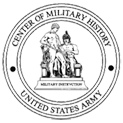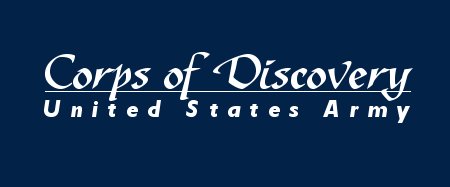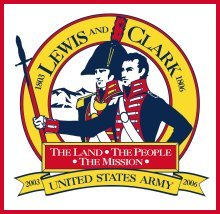The Uniforms and Equipment of the Lewis and Clark of the Expedition
The Lewis and Clark expedition was a military operation. Of the 33 individuals who made the trip to the Pacific, there were two officers in command and 26 enlisted men. Previous scholarship has focused on the places visited and the discoveries made by the expedition, however, little has ever been written about the expedition's uniforms, arms, and accouterments. This article and drawings show the uniforms, weapons, and accouterments worn by the expedition at the time it left St. Louis. It does not address the items carried by civilians nor does it show the modifications and replacements that occurred as time went on. Readers that have additional documents are encouraged to contact the TRADOC History Office.
The United States Army at the time of the expedition was organized under the Military Peace Establishment of March 16, 1802. This organization allowed for two regiments of infantry, one regiment of artillery, a small corps of engineers and the general staff. The Army establishment consisted of a total of 3,287 officers and men. All three line regiments provided soldiers to the expedition.1
The Officers
The commander of the expedition was Captain Meriwether Lewis of the 1st Infantry.2 The uniform of the regiment was detailed in the standing orders of the 1st Infantry dated July of 1802 and signed by Colonel John F. Hamtramck.3 It was particularly detailed as to officer dress. The primary uniform for officers consisted of a dark blue woolen cutaway coat with red woolen collar (known in the period as a 'cape'), cuffs, and lapels. All button holes were trimmed in silver lace. The coat was lined in white woolen shaloon and where the turn-backs for each skirt were secured, there were two red cloth diamonds edged in silver. Lieutenants were to wear a silver lace and bullion epaulette on the left shoulder and captains wore a single silver epaulet on the right shoulder. The opposite shoulder had a dark blue strap edged in silver lace in place of a second epaulet. Field grade officers (majors, lieutenant colonels and colonels) wore two epaulettes. Buttons for the officers of the 1st Regiment were silver with the regimental number, "1" surrounded by "UNITED STATES".4 There were ten buttons on each lapel, four on each cuff, four on the collar, four on each pocket and three on each tail. A single small button secured the epaulette and another secured the opposite shoulder strap. Since sleeves fitted close to the arm, cuffs often closed with two or more small buttons place vertically on the back slit. The coat closed in front with three hooks and eyes; the backward sweep of the front precluded the lapels buttoning over or the coat closing to the waist. Additional features from contemporary portraits show that by 1802 the skirts had the turnbacks sewn down in keeping with English military fashion. Portraits also show the turnbacks to have been edged in red.
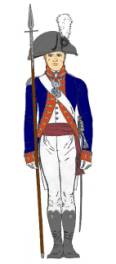
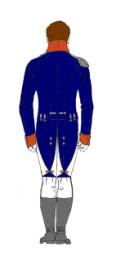
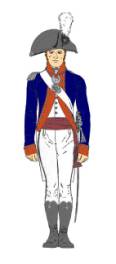
Image 1: Captain of infantry in dress with sword and espontoon. The sash depicted is too dark, it would have been similar in color to the lapels. Sleeves were fitted close to the shape of the arm.
Image 2: Captain of infantry in dress, back view. Notice that the epaulet lays on top of the shoulder and compliments the shoulder line.
Image 3: Captain of infantry in undress with sword. The undress coat simply omitted the lace but was otherwise identical in design to the dress coat. The sash should be red. Note that the fringe to the sash in this period was a continuation of the same thread used in the weave of the sash and they were not the separate bullion knots adopted in 1832.
The coat was worn with a white woolen waistcoat and white woolen pantaloons in winter and a high quality white linen waistcoat and white linen pantaloons in summer. Buttons for the waistcoats would have been regimental. Pantaloons came into fashion late the previous century and were similar to breeches except the legs for pantaloons extended to the ankle instead of just below the knee. The regulation black cocked hat had a black silk cockade with small silver eagle that was held in place by silver lace and a regimental button. The cocked hat still showed vestiges of its tri-corn origins and had not yet become the bi-corn chapeau typical of the War of 1812 era. Around the crown of the hat would have been a silver cord and tassels. A white feather plume completed the headdress. Officer gloves were white buckskin and when the officer was on duty he was to wear a red silk sash and a silver gorget. The boots prescribed for infantry officers were black and cut in the hussar-style with either a scalloped or a pointed front peak and finished with a black tassel. Officers wore black leather or silk stocks in the same manner and for the same purpose as the modern cravat or tie is used.5
Officers had a less expensive undress coat for daily wear and for informal occasions. The undress coat was identical to the dress or uniform coat in all respects except that it omitted the silver lace trim from the buttonholes.6 The waistcoat, pantaloons, boots, gorget, and sash remained as for the formal uniform. Officers of the 1st Infantry also had a red woolen roundabout (a tail-less jacket similar to a sleeved waistcoat) for informal wear during winter months. It was worn with blue woolen pantaloons which were edged along the outseams in white. A simple fashionable black round hat (a top hat) was also permitted for undress and fatigue. Some military round hats carried a cockade on the left side.
For use in inclement or cold weather, company grade officers were prescribed a dark blue surtout (overcoat). The surtout was made of a heavier weight wool then used for the uniform and it extended well below the knee. It was double-breasted on the upper half and single breasted to just below the waist. All buttons were regimental and the coat was lined in red and had a red collar. This overcoat had two capes that were 9 and 10 inches long.7
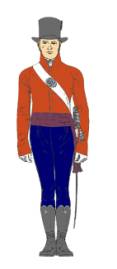
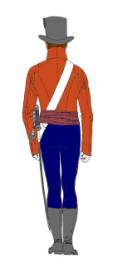
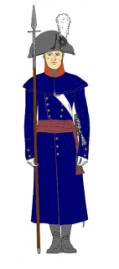
Image 4: Infantry officer in roundabout. Notice the location of the sleevehead. The belt plate color is incorrect and should be silver. The sash should be red.
Image 5: The seams shown show the inset sleeve very clearly.
Image 6: Infantry officer in surtout. The sash should be red.
The second in command was Captain William Clark. This rank is problematical since Clark's commission was as a first lieutenant of artillery.8 Lewis had wanted him returned to active duty as a captain, however, no vacancies in that grade existed so Clark had to accept the lower rank. Although Lewis designated William Clark a co-captain, it is unclear whether he went to the extent of wearing his epaulet on the right shoulder. Personal honor and integrity were the hallmarks of a gentlemen and it is possible that Clark would not have presented himself as a captain unless he had official sanction to do so. Regardless, other then in the placement of the epaulet, there was no difference in the dress of captains and lieutenants. In general, artillery officers wore the same uniform as infantry officers except the lace, buttons, and epaulets were gold instead of silver. The lace and epaulete(s) on the artillery coat were gold bullion.9 All buttons were gilt and featured a cannon with USA&E (for the United States Artillery and Engineers) in script beneath.10 Artillery coats were lined in red, thus the turn-backs were red with blue cloth diamonds edged in gold.11 Except for having gilt artillery buttons, all other garments were as prescribed for infantry officers. Headdress was the same as infantry but with gold trim and devices in place of silver. There are no surviving general orders for artillery officers as were written for officers of the 1st Infantry, however, according to the illustrations in the Gass journal, Clark is shown consistently wearing a round hat so that article was common to both artillery and infantry officers.12 Gass's drawings also show Clark wearing the untrimmed undress coat, which would have been appropriate for the round hat. Clark's boots would have been black made in the hussar style and with a black tassel.
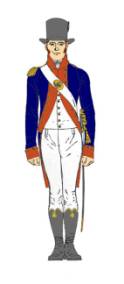
Image 7: Artillery officer in undress and off duty. The artillery uniform for officers was the same as for infantry officers but with gilt buttons and red lining.
Officers were armed with an espontoon and a sword. There was no regulation pattern for each, however, surviving espontoons follow the style shown in the illustrations. Swords for company grade officers could have either straight or curved blades and both artillery and infantry officers carried their swords from a shoulder belt. Scabbards were black leather with either gilt or silver mountings according to the color metal used for the hilt. Artillery officers had sword hilts and mountings in gilt corresponding to their buttons while infantry officers had silver hilts and mountings. The color of the sword knot and breast plate matched the button color, silver for an officer of infantry and gold for artillery.
There are some issues regarding wear of the uniform. The uniform coat, undress coat, and roundabout were fitted garments and were cut differently from present day styles. This is not to say that they were uncomfortable and ill-suited, these garments were for an age that had different ideas as to the function of clothing then Americans do today. Sleeves were cut close to the arm and extended as far as the wrist. The cut of the coat at the area of the armscye was also unique and can be seen in the back views shown in the accompanying plates. Garments made between the mid 1760s to about 1819 had the armscye considerably inset and this presented a somewhat narrow-shouldered look that is very distinctive. Not only was there a narrow shouldered silhouette to the figure, the sleevehead was smoothly set into the armsyce such as to present a smooth line from coat to sleeve. This was certainly no ridge at the beginning of the sleeve as characteristic of present day coats or most reproductions made using modern patterns. The position of the epaulet reflected the tailoring, that is, the epaulet strap buttoned on the collar and not on the shoulder and the strap did not extend beyond the armscye, it was the bullion which fell over the top of the sleeve. The epaulet laid close and conformed to the lines of the shoulder as shown. It did not stand up and project out over the sleeve as happened with epaulet design later in the century. Also, it is not generally appreciated that epaulets were very expensive items by themselves and could cost more then the coat, waistcoat, and pantaloons combined. This brings the question as to how much officers in the field wore their epaulets when on the march, on fatigue, or in camp. The cross strap, or bridle, that held the epaulet in place would by placement on either the right or left shoulder (or both if field grade) have indicated the officer's rank. It should additionally be pointed out that there being little difference in the epaulet itself for any rank except for general officers who had stars on the strap, otherwise, it is the number and placement of the epaulet that indicated the wearer's rank. It is likely that Lewis and Clark would have saved their epaulets for special occasions. Lastly, when wearing the coat, the sash was worn over the waistcoat and under the coat; it was not worn outside of an open faced coat. When wearing the roundabout, the sash was on the outside and tied over the sword belt.
What happened to the two officers' uniforms over the next several years of arduous wear and tear is not known precisely, however, there are some considerations that should be mentioned. The frontier notwithstanding, Lewis and Clark were officers and gentlemen and would have attempted to maintain the dress standards of their class and rank for as long as was possible. America in this period was a very class conscious society and a person's dress and appearance were a fundamental part to their status and image. In all likelihood, the Lewis and Clark had at least two uniforms, the undress and dress coats. Lewis should have had the roundabout as well and both quite probably had their surtouts. They also had a number of shirts and socks for at least the early stages of the expedition. Given the importance placed on appearance, both officers would have contrived to set themselves apart from the enlisted men.
The Enlisted Men
The enlisted men of the expedition comprise two distinct groups. Half of the expedition members that made it to the Pacific coast and the men who returned the boats from the Mandan Villages were enlisted in the regular army prior to the expedition.13 Consequently, these men had regimental clothing issued them by their original units and thus were dressed in the regulation uniform of the infantry and artillery. There is a surprising amount of information on the uniform of this period so it is possible to establish the appearance of these soldiers with some accuracy. A few general rules are necessary. Enlisted dress were similar in their general tailoring to officer clothing, however, their design was different and the materials used were of a lesser quality. Sergeants' uniforms and clothing were made of slightly better cloth but otherwise were identical in design to the rank and file dress.
The infantry uniform consisted of a dark blue cutaway coat, lined white with white turn-backs, and had red lapels, cuffs, and collars.14 These coats were made according to a design approved in 1798 when Congress expanded the Army to meet the demands of a possible war with France. The massive expansion of the Army forced the Quartermaster Department to redesign the previous uniform with an eye toward reducing its cost. A more simplified uniform coat emerged that included a reduction in the number of coat buttons from 44 to 18. The lower number was accomplished by eliminating all collar, cuff and pocket buttons and reducing to 2 the number of buttons on each tail. Furthermore, all lace trim as well as the rear pocket flaps were eliminated, and the turn-backs were non-functional. For all its color, this was a considerably simplified uniform and the changes reduced the cost of the coats from $2.50 to just over $.80.15 As it happened, war with France never materialized and the Army was again reduced. This created a surplus of the 1798 pattern and it was from these stocks of clothing that Lewis and Clark's infantry soldiers received their clothing issue. Infantry uniforms for enlisted men had pewter buttons instead of silver but they were of the same design as officer buttons, that is, they had the regimental number in the center surrounded by "UNITED STATES." The number in the center might differ, however, as the uniforms produced for the expanded Army were for an establishment of 16 regiments. The Quartermaster Department had to use up the surplus stocks so the soldiers of the two infantry regiments that survived the reduction were issued coats bearing regimental buttons numbered 1 through 16 without regard for the regiment they were actually assigned.16 The supply of 1798 coats lasted through the uniform issue of 1803 after the expedition had departed. At that time it was determined that new coats would be required for the 1804 issue and a new pattern was chosen. Consequently, when the expedition returned several years later, the Army had its enlisted men dressed in a different uniform.17
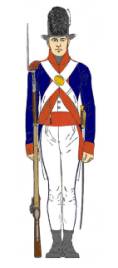
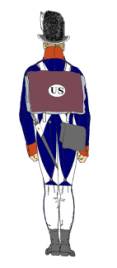
Image 8: Sergeant of infantry. The early years of the Army's existence were ones of great economy. Accouterments manufactured during the Revolution continued to be issued and the plates provided were without regard to the color of the button. The sword shown is from a pattern believed to have been issued to noncommissioned officers of the regular Army at the turn of the century. Most extant swords have brass hilts but there are some examples in steel. The sash should be red.
Image 9: Private of infantry. The knapsack was painted linen.
The remainder of the uniform followed officer dress but with several details unique to enlisted men. Waistcoats were made of a durable white wool, but the waistcoat had neither a collar nor pockets. The overalls were linen for summer with blue edging along the outseams and white wool with blue edging for winter. Though called overalls, the style of this period were relatively close fitting and were called overalls because the base of the leg was open and extended to the ankle. Pantaloons differed in that they were shaped to the leg and tied at the base under the instep. Enlisted overalls were worn with short black painted linen gaiters which were closed with 4 small pewter buttons. In the winter, the overalls were made of white wool and had the outside seam edged in blue, however, the winter overalls were actually gaitered-overalls, that is, the lower leg was cut so as to cover the shoe. These fitted over the top of the shoe and closed tightly around the calf with 3 small buttons.18 Shoes were low quarter and were closed by buckles.
Enlisted headdress prescribed for infantry was distinctly different from what officers wore. The pattern resembled headdress adopted for the Legion during the 1790s and was also similar in design to headdress adopted by the British army for certain units. The American version was a black felt round hat 5-7/8" tall and 7-3/16" with a 3" brim edged with white worsted binding. Over the crown of the hat was a wire reinforced 4" wide strip of bearskin. On the left side was a white deer tail secured by a black leather cockade and pewter eagle.19 For fatigue and when on the march, the bearskin, the deer tail and the cockade were removed.
Undergarments consisted of white linen shirts for summer and woolen flannel shirts for winter. Shirts of the period were quite voluminous and extended to below the crotch. Since underwear was not issued to enlisted men, and were not generally worn anyway, the shirt performed this function and kept the outer garments from getting stained. The shirt was always worn with a black leather stock, which were generally made of a heavier leather then stocks worn by officers.
All noncommissioned rank was distinguished by epaulets. Normally, epaulets followed the button color but were made of worsted wool instead of the officer's bullion, white for infantry and yellow for artillery. To simplify acquisition and distribution of this article for the proposed expanded Army, however, the 1798 uniform had red epaulets for all noncommissioned officers regardless of their branch. Otherwise, the placement of epaulets mirrored that for company grade officers. Corporals wore a single epaulet on the left shoulder and sergeants wore theirs on the right. Sergeants also wore a scarlet worsted sash and carried a sword.20
The artillery uniform was identical to its infantry counterpart except a few small details. The tail lining and turn-backs on the coat were red. Furthermore instead of the pewter infantry buttons the uniform had brass buttons with similar artillery markings to those found on officer buttons.21 In 1802, the artillery uniform was slightly modified. The buttonholes were trimmed with yellow worsted lace and the lapels were sewn permanently to the coat.22 The artillery waistcoats differed from those of the infantry by having collars and brass buttons. Artillery overalls were the same as worn by infantry but with the outer seam edged in yellow. Another difference in their dress was that the men wore cocked hats of a pattern similar to the officer pattern, but the enlisted hat was bound in yellow lace and had a black leather cockade with gilt eagle and a white worsted plume.23
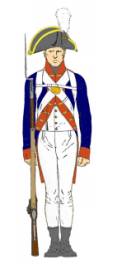
Image 10. Private of artillery. The artillery uniform was distinguished by the yellow lace, brass buttons, and cocked hat. Notice the brass picker and brush. It was suspended from a button on the side nearest where the soldier would have held his musket or rifle to prime the pan in preparation for firing.
For fatigue, all enlisted men wore a linen roundabout.Basically a jacket, it closed with 8 small pewter or brass buttons according to the branch. The pattern jacket remained in use with only minor changes for fashion until the 1850s and it is the forerunner of the modern Battle Dress Utility worn by soldiers. Enlisted men attached to the Lewis and Clark expedition would also have had plain loose-fitting linen trousers and a Russian-sheeting (hemp cloth) fatigue frock. The latte was essentially a large over-shirt.24 The work uniform was completed with a cloth fatigue hat.25 Based on the French Army pattern, these hats resembled an old-fashioned night cap, that is, they were made of two triangular pieces of dark blue uniform cloth from the previous year's coat (the uniform being replaced annually) and were trimmed with red cloth salvaged from the same garment.
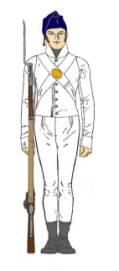
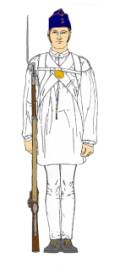
Image 11: Private of infantry in fatigue jacket. Notice the close fit of the jacket and sleeves. The length of the sleeves extended to the hand. The fatigue hat was made of old uniform cloth and had the regimental number on the front.
Image 12: Private of infantry in fatigue frock. This shows the loose fit of the pullover frock and the close fitting overalls.
The basic uniform dress was to suffice for most weather conditions, hence the need to replace it annually, but the War Department did provide cold weather clothing. In winter, each company had a supply of watch coats at a ratio of 1 coat for every 4 to 6 enlisted men in the command. These coats were not issued to individual soldiers but were for use by the men as they stood watch, simply trading them off as the guard changed. These coats were made of a heavy drab melton wool. Since watch coats were company property none of the soldiers transferred from regular units had these garments, however, Lewis did receive 15 of these coats from the Quartermaster Department. The number of coats indicates that they were probably intended for the 15 men specifically recruited for the expedition.26 The other soldiers are believed to have had blanket coats of heavy white wool with blue trim. According to the standing orders for the 1st Infantry, sergeants were issued officer pattern surtoutsbut made of an inferior quality wool.27
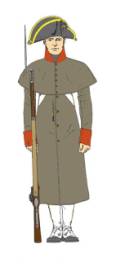
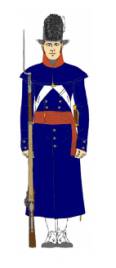
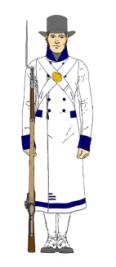
Image 13: Private of artillery in watchcoat. The watchcoat is based on civilian overcoats of the period. The cape is incorrectly shown, it would have flared outward. Accouterments were worn outside of the coat. Notice the gaitered overalls.
Image 14: Private of infantry in watchcoat. Issued on basis of one coat to every 4-6 men in an infantry regiment.
Image 15: Private in blanket coat. The three bars indicated the weight of the blanket wool.
Firearms and accouterments carried by the infantry and artillery soldiers were as used by the rest of the Army. The musket and bayonet were of the model adopted in 1795. Since the 1795 musket was a flintlock, each soldier also had a brass brush and picker for keeping the pan clean when firing. The bayonet was carried in a black leather scabbard suspended from a shoulder belt. Ammunition was carried in a large black leather cartridge box of a pattern adopted by the Continental Army during the Revolutionary War. Soldiers also had their bedding blanket and personal items in a knapsack of the type produced initially for the Army in 1792. There is no evidence of either haversacks or canteens being provided to the expedition.
In addition to the soldiers from infantry and artillery units, there was a third group of men and they had a uniform unique to them. There were 15 men recruited specifically for the expedition. As they were not affiliated with any regular unit, it was decided to provide them a distinctive dress. The notable feature of their uniform was a drab colored coatee.All that is known about the coatees is from a list of materials delivered to Philadelphia tailor Francis Brown on 6 June 1803.28 The pattern for the standard coat of the time would not fit on the allotted cloth. What could be cut was a double-breasted jacket of the sort referred to in the period as a roundabout or jacket. The term coatee described a coat having short skirts and sometimes the skirts were so short as to make the garment almost indistinguishable from a roundabout or jacket. During the American Revolution, some quartermaster clerks used the term coatee and jacket interchangeably. This pattern allowed for 18 coat buttons to close the front, two small buttons to close each cuff and two small buttons to secure the shoulder straps.29 The argument favoring a double breasted jacket is supported by the absence of waistcoats for these soldiers. The regulation uniform coat required a waistcoat to cover the exposed area in front and the absence of this garment suggests that it was not required.30
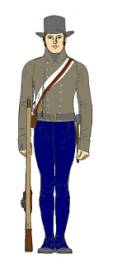
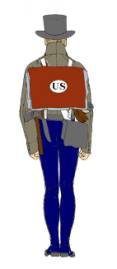
Image 16: "Recruit" rifle uniform. It appears that both cartridge box and shot pouch with powder horn were provided to this group. The waistbelt for the knife and tomahawk is black leather and is based on extant civilian examples. They show the tomahawk suspended from a pouch made to hold the blade.
Image 17: "Recruit" back view. The coat is shown without tails. The absence of much cloth for lining or interfacing suggests a very simple garment.
Further argument in favor of roundabouts in lieu of cut-away coatees as the garments issued to the recruits is based on what materials were not included in the materials lists. To construct a cut-away coatee of the type currently in use in the Army, woolen and linen lining material as well as three hooks and eyes were required. Curiously, no linen for interfacing the collar and fronts as well for making two pocket linings was included in the materials list. The silk twist listed was a heavy thread used for making buttonholes. It was then inferred that the garments were unlined and had no pockets though a small amount of linen was used as interfacing. Another telling absence in the lists of clothing provided to the so-called recruits is waistcoats. The regulation uniform coat required a waistcoat to cover the exposed area between the edges of the false turn-backs. A soldier would not have worn just his shirt under his coat. The absence of these garments suggests that they were not required. Perhaps savings from not providing waistcoats justified the cost of the coatees . 30
The recruit coatees were made from super fine milled drab cloth.31 Super fine was a very high quality woolen cloth with a tight weave and heavily felted surface nap. The goods were so tight that exposed cut edges could be used without risk that the material would unravel. It was used for the very best civilian coats and officers' uniform coats. As such it was much superior to the woolen cloth used for enlisted men's coats by the Army. The term drab refers to a range of color between light gray and medium brown. The decision for a closed front uniform coat was in keeping with changes occurring with enlisted men's dress in the English Army and it predates the closed front coat adopted by the American Army in 1810.32
The remainder of the special detachment's uniform consisted of the surplus clothing intended for the expanded Army. Instead of the regular Army soldier's white overalls, the 15 men received obsolete pattern blue woolen overalls edged along the outseam in white. Except for the watchcoats, their shoes, fatigue frocks, and both linen and flannel shirts were as issued to all soldiers.33 No hats were provided to the recruits and they are depicted in the "common hats" typical of the period.
In addition to the unique uniform, the new enlistees were armed with rifles. The weapon was the 1792/1794 contract rifle that was shortened and fitted with rifle sling swivels, which matched the slings drawn for them by Lewis.34 As was customary for riflemen they were also provided with a waist belt, a rifleman's pouch, powderhorn, knife and scabbard, and a tomahawk.35 Lewis had 15 rifle pouches and powder horn sets produced by Robert C. Martin.36 He also provided extra powder horns and cartridge boxes. Like the regulars these men were provided backpacks and blankets but again there is no evidence of haversacks or canteens being issued.37
The clothing, equipment, and arms carried by the expedition were sufficient to deal with any eventually. Availability of fatigue clothing meant that the primary uniform garments would have been spared for a time, however, they are not likely to have lasted the length of the expedition. References in the expedition's journals suggests that later in the expedition Lewis and Clark attempted to replace worn out items of uniform with similar garments made of buckskin. Regardless as to when and how the soldiers' clothing evolved, the military character of the expedition would have been evident from the arms, accouterments, and equipment carried by its members.
Endnotes
1. Heitman, Francis B., Historical Register and Dictionary of the United States Army, Vol. 2, Government Printing Office, Washington, 1903, p. 569.
2. Heitman, Francis B., Historical Register and Dictionary of the United States Army, Vol. 1, Government Printing Office, Washington, 1903, p. 631.
3. Hamtramck, Col. J. F., Standing Orders of the First Regiment of Infantry, 1802 , Detroit, July 26, 1802, Orderly book collection (item 104), Library of Congress, Washington D. C.
4. Albert, Alphaeus H., Record of American Uniform and Historical Buttons with Supplement, Boyerstown Publishing Company, Boyerstown, PA, 1973, pp. 16-18.
5. The complete uniform is described in Hamtramck, Col. J. F., Standing Orders of the First Regiment of Infantry, 1802. The Uniform is best illustrated by a portrait of Captain David Bissell, 1st Infantry, dated 1803, in the collection of the David Bissell Mansion, St. Louis Parks, St Louis, MO.
6. Hamtramck, Col. J. F., Standing Orders of the First Regiment of Infantry, 1802 , Detroit, July 26, 1802, Orderly book collection (item 104), Library of Congress, Washington D. C.
7. Ibid.
8. Heitman, Francis B., Historical Register and Dictionary of the United States Army, Vol. 1, Government Printing Office, Washington, 1903, p. 306.
9. United States Army, General Order, Headquarters, Loftus heights 2, January 1799, General Order Headquarters, Natchez 26 February 1800, Uniform of the Army of the United States,1774-1889, Quartermaster General, Washington, 1890.
10. Albert, Alphaeus H., Record of American Uniform and Historical Buttons with Supplement, Boyerstown Publishing Company, Boyerstown, PA, 1973, pp. 46-47.
11. United States Army, General Order, Headquarters, Loftus Heights, 2 January 1799, General Order Headquarters, Natchez, 26 February 1800, Uniform of the Army of the United States,1774-1889, Quartermaster General, Washington, 1890.
12. Gass, Patrick, Journal of the Voyages and Travels of a corps of Discovery, Under the Command of Capt. Lewis and Capt. Clarke..., 3rd ed. Philadelphia, 1811, Reprinted by A. C. McClurg & Co., 1904.
13. Clarke, Charles G., The Men of the Lewis and Clark Expedition, The Arthur C. Clark Co., Spokane, Washington, 2001.
14. United States Army, General Order, Headquarters, Loftus Heights, 2 January 1799, General Order Headquarters, Natchez, 26 February 1800, Uniform of the Army of the United States,1774-1889, Quartermaster General, Washington, 1890.
15. Finke, Detmar H. & McBarron, H. Charles, The Infantry Enlisted Man's Coat, 1804-1810 , Military Collector and Historian, Vol. XL No.4, Washington, D.C,1988, pp. 162-164.
16. Albert, Alphaeus H., Record of American Uniform and Historical Buttons with Supplement, Boyerstown Publishing Company, Boyerstown, PA, 1973, pp. 16-18.
17. Finke, Detmar H. & McBarron, H. Charles, The Infantry Enlisted Man's Coat, 1804-1810, Military Collector and Historian, Vol. XL No.4, Washington D.C, 1988, pp. 162-164.
18. Finke, Detmar H. & Marko Zlatich, The Army Clothing Estimate for 1804 , Military Collector and Historian, Vol. XLVI, No.2, Washington D.C, 1994, pp. 55-58. XLIV, No.1, Washington D.C, 1992, pp. 32-33.
19. Zlatich, Marko, U.S. Infantry hat, 1801-1811, Military Collector and Historian, Vol. XLIV, No.1, Washington D.C., 1992, pp. 32-33.
20. United States Army, General Order, Headquarters, Loftus Heights, 2 January 1799, General Order Headquarters, Natchez, 26 February 1800, Uniform of the Army of the United States,1774-1889, Quartermaster General, Washington, 1890.
21. Ibid.
22. Finke, Detmar H. & McBarron, H. Charles, The Infantry Enlisted Man's Coat, 1804-1810, Military Collector and Historian, Vol. XL No.4, Washington D.C., 1988, pp. 162-164.
23. United States Army, General Order, Headquarters, Loftus Heights, 2 January 1799, General Order Headquarters, Natchez, 26 February 1800, Uniform of the Army of the United States,1774-1889, Quartermaster General, Washington, 1890.
24. Finke, Detmar H., Army Linen Garments, 1801-1813 , Military Collector and Historian, Vol. XLVI, No.2, Washington D.C, 1994, pp. 50-51.
25. Hamtramck, Col. J. F., Standing Orders of the First Regiment of Infantry, 1802 , Detroit, July 26, 1802, Orderly book collection (item 104), Library of Congress, Washington D. C.
26. Jackson, Donald, Letters of the Lewis and Clark Expedition With Related Documents, 1783-1854, University of Illinois Press, Urbana, 1962, p. 98, (note Jackson lists these as "Match Coats" which seems to be a miss-transcription of "Watch Coats").
27. Hamtramck, Col. J. F., Standing Orders of the First Regiment of Infantry, 1802, Detroit, July 26, 1802, Orderly book collection (item 104), Library of Congress, Washington D. C.
28. Jackson, Donald, Letters of the Lewis and Clark Expedition With Related Documents, 1783-1854, University of Illinois Press, Urbana, 1962, p. 92.
29. Shaw, Thomas G. & Abolt, Stephen, Research used to reconstruct a reproduction "recruit coatee" for the Frontier Army Museum, Fort Leavenworth Kansas, 1998.
30. Ibid.
31. Jackson, Donald, Letters of the Lewis and Clark Expedition With Related Documents, 1783-1854, University of Illinois Press, Urbana, 1962, p. 92.
32. Shaw, Thomas G. & Abolt, Stephen, Research used to reconstruct a reproduction "recruit coatee" for the Frontier Army Museum, Fort Leavenworth Kansas, 1998.
33. Jackson, Donald, Letters of the Lewis and Clark Expedition With Related Documents, 1783-1854, University of Illinois Press, Urbana, 1962, p. 98.
34. Ibid, p.98.
35. Ibid, p.98.
36. Ibid, p.90.
37. Ibid, p.98
.
